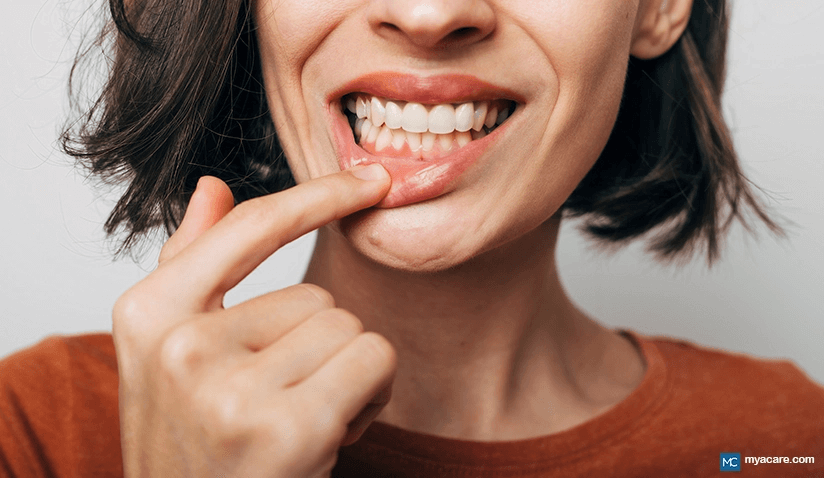Gum Diseases: A Silent Epidemic

Article Updated 27 July 2021
Gum diseases (or periodontal diseases) are inflammatory and cause destruction of tissues including the bone supporting the teeth. There are two types of periodontal disease: gingivitis (inflammation of gums) and periodontitis (inflammation of tissues supporting teeth). If untreated, gingivitis can progress to periodontitis, an advanced form of the disease. Gum diseases are also known as a silent epidemic, as they go unnoticed in the initial stages until the disease progresses to cause loss of teeth.
Epidemiology
Chronic gingivitis is the most common type of gum disease which affects ~90% of adults globally, primarily younger adults.
Severe periodontitis is one of the most common diseases globally with a prevalence of 11.2%, affecting ~743 million people. Older adults are more prone to periodontitis.
Causes
The main cause of gum diseases is:
- Presence of microorganisms: The main cause of the disease is accumulation of deposits around the surfaces of teeth and gums. These deposits are known as plaque and calculus (mineralized plaque) which are breeding ground for microorganisms (especially bacteria).
Contributing factors: Factors which contribute to gum diseases include:
- Local risk factors: The presence of factors such as poor oral hygiene, trauma from tooth brush, presence of crowded teeth, faulty fillings or crowns, and dryness of mouth (reduced self-cleansing action of saliva) encourages the accumulation of plaque and calculus, contributing to diseases.
- Systemic risk factors: The presence of these factors negatively affect inflammatory response to dental plaque, causing exaggerated inflammation. These factors include:
- Smoking: The nicotine in cigarettes causes constriction of blood vessels in the gums and encourages influx of microorganisms and inflammatory mediators, resulting in gum diseases.
- Metabolic factors: Elevated blood sugar levels activate the inflammation-causing mediators, exaggerating the inflammatory response to existing gum infection in diabetics.
- Nutritional factors: Deficiency of Vitamin C (antioxidant) decreases the ability to remove toxins and weakens the blood vessels, enhancing the bleeding of gums.
- Medications: Intake of specific medications such as calcium-channel blockers, anti-epileptics, and anti-hypertensives cause dryness of mouth and enlarge gums, increasing susceptibility to gum diseases.
- Hormones: Elevated sex steroid hormones during puberty or pregnancy, and intake of oral contraceptives can exaggerate the inflammatory response of the gums even in the presence of a small quantity of plaque.
- Other systemic disorders: Presence of disorders such as leukemia, HIV, clotting deficiencies, or decreased platelet count can cause gum inflammation even in the presence of a negligible amount of plaque.
- Stress: Increased stress can elevate the levels of cortisol hormone in the body which affects gums. Individuals with high stress also tend to smoke or drink alcohol which have deteriorating effects on the health of gums.
Pathophysiology
Gum or periodontal disease involves inflammation and degeneration of tissues supporting the tooth such as gums, bone, periodontal ligament, and cementum (layer on tooth root). The presence of dental plaques harbor ~400 species of bacteria. The bacteria release toxins on several sites underneath gums. These toxins activate the inflammatory response and result in destruction of tissues surrounding the tooth, leading to inflammation of gums in the initial stage followed by bone loss and loosening of teeth in advanced stage.
Clinical features
In gingivitis, individuals usually complain of redness and presence of swollen gums, bleeding from gums while brushing teeth, presence of sensitivity, soreness, and bad odor. Meanwhile, in periodontitis individuals complain of reddish and swollen appearance of gums, release of pus, increased spacing between teeth, bleeding of gums while brushing, dull aching pain, increased food lodgment, bad breath, presence of periodontal pockets (space between tooth and gums), receded gums, sensitivity in teeth, loose teeth, and difficulty while eating. Overall, periodontal diseases reduce the quality of life of an individual.
Diagnosis
The disease can be diagnosed based on the analysis of clinical findings, medical examinations, and radiographic examinations.
- Clinical examination: The evaluation of signs and symptoms based on color, texture, consistency of gums, probing depth (measurement of pockets using an instrument), and mobility of teeth can help diagnose the disease.
- Medical examination: It includes laboratory tests which help determine the systemic health of the individual. These tests include complete blood picture, clotting bleeding time, blood sugar levels, nutritional status of individual, and bone marrow studies.
- Radiographic examination: The presence or absence of bone in radiographs (OPG) or CBCT (Cone beam computed tomography) help diagnose the disease. This analysis also helps determine the possibility of bone regeneration based on the type of bone loss present.
Treatment
- Management of individuals with periodontal disease depends on the extent and severity of the disease.
- In individuals with gingivitis, treatments such as professional cleaning of teeth, use of anti-bacterial mouthwash, use of interdental cleaning devices (floss and interdental brushes), intake of Vitamin C supplements, correction of crowded teeth or faulty brushing habits, and correction of faulty fillings and crowns can restore the health of the gums.
- In individuals with periodontitis, mild to moderate form of disease can be managed by non-surgical therapy which includes scaling and root planing of teeth (deep cleaning) with antibiotic therapy, if required. In advanced stage of the periodontal disease, gum surgery is recommended, possibly accompanied by placement of bone grafts.
Prevention
- Gum diseases can be prevented if the following measures are adopted by the individual:
- Regular maintenance of gums through measures such as regular cleaning of teeth by a dentist, brushing twice daily, use of mouthwash as prescribed, and use of interdental brushing aids such as floss and interdental brushes.
- Avoidance of refined sugars between meals, and smoking or chewing of tobacco.
- Intake of balanced diet (including Vitamin C) to avoid any nutritional deficiencies.
Complications
Research suggests that periodontal diseases are also associated with several systemic diseases such as cardiovascular diseases, diabetes, respiratory disorders, rheumatoid arthritis, cancer, and pregnancy related complications (e.g., low birth weight of infant, preterm labor, high blood pressure during pregnancy). In addition to this, the American Academy of Periodontology (a leading organization of gum disease experts) has reported that people with severe gum diseases are at greater risk of developing a severe form of COVID-19 infection. These people are likely to experience COVID-19 complications or may require ICU beds with assisted ventilation.
To search for the best healthcare providers offering dentistry, please use our search engine. We currently have providers in India, Malaysia, Singapore, Spain, Thailand, Turkey, the UAE, the UK and the United States
To search for the best healthcare providers worldwide, please use the Mya Care search engine.

Dr. Shilpy Bhandari is an experienced dental surgeon, with specialization in periodontics and implantology. She received her graduate and postgraduate education from Rajiv Gandhi University of Health Sciences in India. Besides her private practice, she enjoys writing on medical topics. She is also interested in evidence-based academic writing and has published several articles in international journals.
Sources:
Featured Blogs



